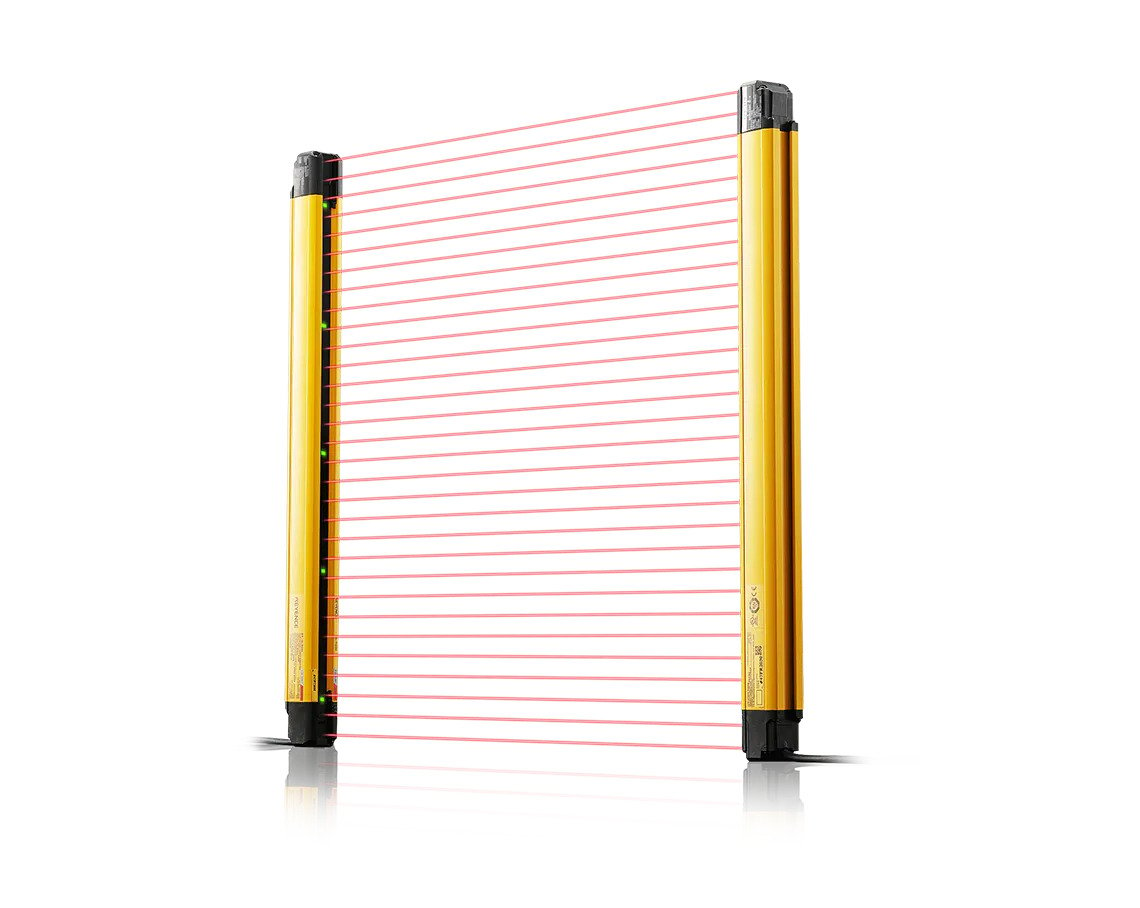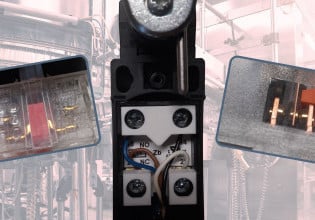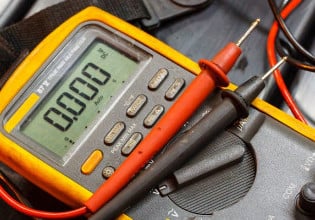Introduction to Safety Light Curtains: Operation and Installation
Light curtains serve as an invisible barrier, keeping workers out of harm's way and protecting machinery from damage. Learn about safety curtains, how they are installed, and their programmable functions.
Light curtains are used in a wide variety of industrial robotic and automation applications. The main function of most light curtains is to serve as an invisible indicator of entry between hazards inside an automated cell and the rest of the factory operating around it. Primarily used as an emergency stop (E-stop) indicator to keep factory workers out of harm's way, light curtains serve a vital function in many different automated processes, functioning as an invisible safety gate.

Figure 1. Safety light curtains are sensors that function as an invisible barrier to keep workers safe and prevent damage to machinery. Image used courtesy of Keyence
What is a Safety Light Curtain?
Light curtains are long cylindrical sensors that generally contain a transmitter and a receiver. The transmitting side of the curtain sends a laser across the space to be protected and the receiver accepts the signal. When a receiver stops seeing a signal from the transmitter, caused by something or someone in the signal’s path, an E-Stop is triggered for the motion devices in the machine being safeguarded.
Light curtains are designed to be active whenever the cell is operating and inactive whenever operators need to be inside of the cell, often determined by the application they are used in.

Figure 2. Eliminating the need for operators to manually open and close safety gates, light curtains help to make operating processes more efficient. Image used courtesy of Banner Engineering
Light Curtain Basics
Although unique applications for light curtains will determine placement and control, there are a number of best practices and common applications, universal to the use of light curtains.
Light curtains are safety regulated and approved for use in safety circuits allowing them to be used for E-Stop purposes. They are more complex than other photoelectric sensors and have the ability to monitor themselves with the use of redundant signals, meaning they can stop an internal hazard when an internal fault is detected. Two sets of output signals must provide matching ‘active’ signals. If any internal circuitry fails, one or both outputs will de-energize, triggering an E-stop event. This distinction means that they conform to regulations designed to safeguard dangerous machinery and robotic cells.
In addition to making cell operation more efficient by eliminating the need for operators to open and close gates, they can also reduce the cost of the initial cell design in certain cases by eliminating sections of expensive, labor intensive physical safety fencing.

Figure 3. Rockwell Automation’s 450L GuardShield PAC Safety Light Curtains are one of many light curtain options on the market. Image used courtesy of Rockwell Automation
Light Curtain Installation
When designing an automation cell, it is important to understand the options available to create the most cost effective and efficient design. There are many manufacturers of light curtains and research into an appropriate curtain should be completed before installation. Some common light curtain manufacturers include:
-
Keyence
-
Banner
-
IFM
-
Omron
-
Autonics
-
Reer
Once an appropriate light curtain has been chosen for the application, it will need to be placed in the location to cover the safety area.
Light curtains should make it impossible for a worker to come into contact with machinery or robots before motion has been safely halted. With this in mind, it is important to make sure that the light curtain cannot be circumvented by a worker. In other words it needs to be appropriately large enough that no one can go beneath or above the curtain to reach the machinery inside.

Figure 4. Following certain safety standards when installing light curtains can help ensure worker safety. Image used courtesy of SICK
Unlike a tangible barrier, light beams cannot actually prevent physical access. This distinction is important because the light curtain is still employed to protect workers in the case of accidental entrance into the cell. This means that it should be far enough back from the system that if someone were to reach or fall into the cell, any hazardous motion would have time to fully come to a stop before the person reached it. Safety standards should be consulted when designing the safety systems for a newly designed cell.
Once appropriate parameters for the proper installation of a light curtain system have been considered, the light curtains can be installed. The installation procedure usually involves mounting the light curtains in their appropriate locations and then aligning them for proper reflection and reception. Once the curtains are aligned, they can then be added into the safety system for the cell. The output circuits are wired directly into the safety system for the entire cell, proceeding directly into a safety relay or safety PLC.
Programmable Light Curtain Functions

Figure 5. Programmable functions in light curtains include restarting, muting, and blanking. Image used courtesy of IFM
Restarting
After the physical installation of a light curtain, thought needs to be placed into the proper programming of the light curtain. Light curtains have a number of variable functions that them more appropriate and useful for different applications while still retaining safety compliance.
Restart interlocking methods are important to the use of light curtains and constitute how a light curtain system acts after something has broken the safety of the light curtain. Restart interlocking modes of safety light curtains can be set up in two ways, either automatic or manual.
Automatic restart means that as long as the light curtain does not detect an obstruction, light curtains will not give a fault to the safety system. This type of restart should only be used in applications where it is not possible for an operator or obstruction to be inside of the cell completely, such as in the hand guarding smaller machines.
The method of manual restart for light curtains involves the push of an external button to reset the safety once the light curtain has been tripped. This is the recommended method for larger cells where an operator can fit entirely inside. It ensures that the operator must be outside of the cell before it is manually restarted, and has not exited from the range of the light curtain while still inside the dangerous machine.
Muting
Muting is the process of stopping the light curtain from detecting certain objects as they travel through the light curtains zone without stopping the safety circuit. This allows necessary material to travel through the light curtain’s path while the curtain is still able to detect the presence of workers should they cross the light curtain zone.
There are many different ways to successfully mute light curtains while retaining safety for the cell. Muting is particularly important for conveyor line systems where the product needs to exit the cell through the light curtain protected area, but should certainly not cause an emergency shutdown each time an object is transported.
Blanking
Blanking is a similar process to muting, but is a more permanent configuration–completely ignoring the detection capabilities of one or more beams of the light curtain.
An example case for blanking would be a conveyor belt passing through the middle of the light curtain, but the areas above and below the conveyor still must be monitored for safety. The section occupied by the conveyor in the center of the light curtain may be intentionally blanked and not monitored by the light curtain.
Blanking can be useful in many different circumstances, but a proper safety analysis should be performed to make sure that the light curtain is still performing properly and will protect workers effectively.
Light Curtain Safety
Light curtains form an integral part of most robotic cells and automated systems. They help to keep workers out of harm's way and can even be used to protect machinery from damage. They create an effective method for safeguarding many systems and often help to reduce the cost of safety fencing.
In addition, light curtains often outlast physical switches on doors and other monitoring safety systems since no physical contact with the light curtain is necessary. Careful consideration should be taken when designing a cell with a light curtain to ensure worker safety in all working conditions and scenarios.






